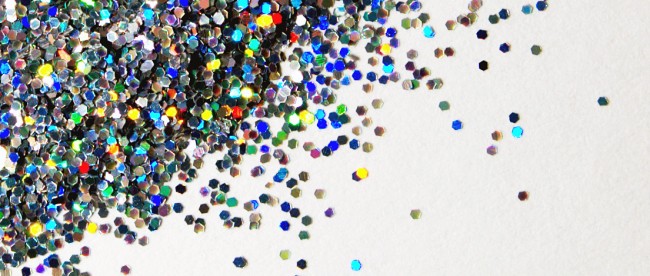A Sparkly Way to Solve a Crime

Glitter. It’s a neat-freak parent’s worst nightmare. It gets everywhere, spreading like a sparkly plague well beyond the nominal bounds of your child’s art project. You’d be a fool to buy a t-shirt adorned with the stuff unless you want glitter all over your house and sprinkled within whatever laundry that shirt ends up washed with. Glitter is incredibly difficult to clean up — days later, you’re nearly certain to find some specks glistening around the kitchen table and everywhere else. In a FAQ about glitter, Mental Floss asks itself “how can you clean up after a glitter spill?” and then begins its answer, simply, with “you can’t.”
Which is why you or your victim shouldn’t be wearing any if you want to commit a crime. Well, part of why.
In 1987, a researcher named M.C. Grieve published a paper in the Journal of the Forensic Science Society wondering if glitter particles may be “an unusual source of trace evidence” — small clues that can help link a person to a crime scene. As Grieve notes, it turns out that glitter comes in all sorts of shapes, sizes, colors, etc., with many different manufacturers. There are thousands and thousands of different combinations, which means that the glitter left behind at a crime scene won’t match all other glitters — just a small percentage of the stuff. That left-behind glitter, then, isn’t just evidence as to whether the criminal had glitter on his or her sleeves — it’s also possible to narrow down the source of the glitter significantly. If upon a search of the criminal’s home, investigators find a glittery t-shirt, they can use it to create a stronger link to a crime. It’s not dispositive — anyone who has that shirt or another product made from the same glitter manufacturer could also be guilty — but it certainly helps remove reasonable doubt.
Or, at least, that’s how Grieve’s theory went. In practice?
He’s right.
A few years ago, a retired criminalist and senior chemist for the Naval Criminal Investigative Service, Bob Blackledge, explored the question further in a paper (pdf) for the National Forensic Science Technology Center titled, simply, “Glitter as Forensic Evidence.” Blackledge outlined seven key factors that forensic investigators use to determine whether trace evidence of a contact exists, signaling that a suspect was present at a crime scene. Glitter matched all seven, and easily. Further, Blackledge went beyond theory: he identified a handful of examples where glitter was used to connect a suspect to the crime. Here’s a tragic example, via Blackledge:
A highway in Florida had a center lane that was only supposed to be used for turning. A vehicle containing a mother and her daughter was stopped in this lane when a pickup truck driving in the center lane smashed into the stopped vehicle and both the mother and daughter were killed. When police arrived no one was in the pickup truck. However, an intoxicated woman was found hiding nearby in the brush. She denied being the driver, but she was wearing cosmetic glitter and at the instant of impact some of her glitter was transferred to the driver’s side airbag.
There are many other examples as well — both in Blackledge’s paper and beyond. For example, in a 1992 murder case out of Alaska, an appeals court decision noted that “FBI Agent Robert Webb testified as a polymer expert that glitter particles found on the decedent’s body and clothing, and the medical examiner’s sheets, were ‘identical’ or ‘consistent’ with the glitter samples surrendered by [the defendant].”
So yes, the glitter may make a terrible mess — but don’t freak out too much and do something you may regret. You won’t get away with it.
Bonus fact: In January of 2015, an Australian entrepreneur named Mat Carpenter had the idea for a new, evil-as-a-service startup: ShipYourEnemiesGlitter.com. For a fee, Carpenter would — anonymously — send an envelope of glitter to a friend, enemy, or worse on your behalf. The sadistic humor found many fans online and within 24 hours, the website proved extraordinarily popular — Carpenter later claimed that more than a million people visited his site placing orders totaling in the five-figure dollar range. The popularity was too much for what was likely intended to be a joke, and Carpenter never shipped any of the ordered glitter bombs. However, others did — within two weeks of launch, he sold the site for $85,000, and the new owners fulfilled the purchases.
From the Archives: Targeting Crime: Target isn’t just a huge store — it’s also a secret crime lab.
Related: Glitter. Lots and lots of glitter.
